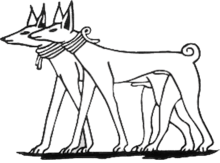Tesem
 A drawing of two Tesems | |
| Other names | tsm |
|---|---|
| Origin |
|
| Patronage | Egypt |
| Breed status | Extinct |
| Domestic dog (Canis lupus familiaris) | |
Tesem (![]() = tsm) was the Ancient Egyptian name for "hunting dog". In popular literature it denotes the prick-eared, leggy dog with a curled tail from the early Egyptian age, but it was also used with reference to the lop-eared "saluki/sloughi" type;[1] it was one of several types of dogs in Ancient Egypt, particularly the latter type had an appearance most similar to that of a greyhound.
= tsm) was the Ancient Egyptian name for "hunting dog". In popular literature it denotes the prick-eared, leggy dog with a curled tail from the early Egyptian age, but it was also used with reference to the lop-eared "saluki/sloughi" type;[1] it was one of several types of dogs in Ancient Egypt, particularly the latter type had an appearance most similar to that of a greyhound.
History

Three main types of dogs are shown in Ancient Egypt, these being the pariah dog, the greyhound-like dog and a molosser-type dog.[2] It is assumed that there were two types of greyhound-like breeds, these being the older Tesem[3] and the saluki/sloughi type.[4] The two greyhound-types were clearly distinguished in tomb decorations,[5] with the Tesem thought to be similar to modern pariah dogs.[6] One scholar applies the name Tesem to both types of greyhound-like dogs.[1]
The prick-eared Tesem's origins are presumed to be from further south than Egypt, from Nubia and also the Land of Punt,[7] whose location is unclear but thought to be to the south east of Egypt on the Horn of Africa.[8]
A drawing of a Tesem type dog appears in Nagada, dated from the Protodynastic Period of Egypt (dated 3200 BC to 3000 BC). The dogs were drawn with upright ears and a tightly curled tail.[9] One of the earliest known recordings of these dogs is the "Khufu dog" from the tomb of King Khufu,[10] who reigned between 2609–2584 BC.[11] This dog was named Akbaru, and was depicted wearing a collar.[10]
They continued to appear during the Middle Kingdom period (2055 BC and 1650 BC), but by the time of the New Kingdom (1550 BC - 1069 BC), they were replaced by dogs with hanging ears and a straight tail.[9] These dogs were of the saluki/sloughi type.[12]
The Pharaoh Hound of Malta and the Cirneco dell'Etna of Sicily were both popularly and controversially thought to be possible descendants of the Tesem.[13] [14]
Description
Ancient Egyptians gave the name Tesem to the early curly tailed dogs that resembled a sighthound.[15] These dogs were featured on monuments,[15] and in wall paintings that showed their lean body with noticeable prick ears.[7] They had a greyish-yellow coat, with long legs and a broad prominent forehead. Their size exceeded the Pariah dogs of the time. The structure of their skeleton was closer to the modern terrier than that of the modern greyhound.[16]
See also
References
- 1 2 Brixhe, Jean. 1996 Lévriers, chiens de chasse, de travail et de compagnie dans l'Egypte ancienne. University of Liege
- ↑ "The manners and customs of the ancient Egyptians". Archive.org. Retrieved 2012-10-24.
- ↑ "Life in ancient Egypt". Archive.org. Retrieved 2012-10-24.
- ↑ "Life in ancient Egypt". Archive.org. Retrieved 2012-10-24.
- ↑ Goldwasser (2002): p. 106
- ↑ Goldwasser (2002): p. 93
- 1 2 The Origins and Development of African Livestock: Archaeology, Genetics, Linguistics and Ethnography (Blench, Roger; MacDonald, Kevin ed.). Routledge. 1999. p. 317. ISBN 978-1-84142-018-9.
- ↑ Najovits, Simson (2004). Egypt, the Trunk of the Tree. Algora Publishing. p. 258. ISBN 978-0-87586-256-9.
- 1 2 Bard, Kathryn A. (1999). Encyclopedia of the Archaeology of Ancient Egypt. Routledge. p. 359. ISBN 978-0-415-18589-9.
- 1 2 Cunliffe, Juliette (1999). The Encyclopedia of Dog Breeds. Bath: Paragon. p. 70. ISBN 0-7525-8018-3.
- ↑ Hamblin, William J. (2006). Warfare in the Ancient Near East to 1600 BC. Routledge. p. 331. ISBN 978-0-415-25589-9.
- ↑ Goldwasser, Orly (2002). Prophets, Lovers and Giraffes. Harrassowitz Verlag. p. 93. ISBN 978-3-447-04590-2.
- ↑ Mormino, Vincenzo. "The Sicilian Hound". Best of Sicily Magazine. Retrieved 11 February 2011.
- ↑ Petr Fismol. "Pharaoh hound - el Negma kennel". Elnegma.com. Retrieved 2012-10-24.
- ↑ Lydekker, R (1916). Wild Life of the World. III. London: Frederick Warne and Co. p. 19.
Goldwasser, Orly (2002). Prophets, Lovers and Giraffes. Harrassowitz Verlag. ISBN 978-3-447-04590-2.